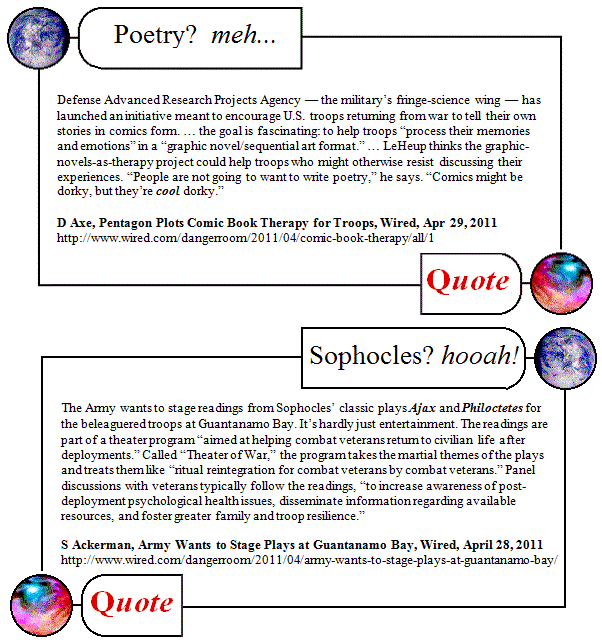When does music become noise?
Tuesday, July 17th, 2012[ by Charles Cameron — a little rock criticism with military, political and theological overtones ]
.
When does music become noise?
- When it annoys you.
- Even when it’s Nancy Sinatra.
- And FWIW, much the same can be said of prayer.
I say this, because there’s currently a battle of the noises in Jerusalem. Or should I call that a battle of rock music vs the call to prayer?
Noise, in any case. That’s what the people who don’t like it call it.
**
It may be that you’ve sought out events with “strobe lights and screamingly loud rock and rap music” — they’re called concerts when you volunteer for them, but torture when you have no choice…
**
The New York Times piece quoted above brings us a legal opinion that the practice at Gitmo constituted torture, and a hint of the playlist:
David Sheffer, a senior State Department human rights official in the Clinton administration who teaches law at George Washington University, said the procedure of shackling prisoners to the floor in a state of undress while playing loud music – the Guantánamo sources said it included the bands Limp Bizkit and Rage Against the Machine, and the rapper Eminem – and lights clearly constituted torture. “I don’t think there’s any question that treatment of that character satisfies the severe pain and suffering requirement, be it physical or mental, that is provided for in the Convention Against Torture,” Mr. Sheffer said.
It also tells us what impact of the “strobe lights and screamingly loud rock and rap music” had on the Gitmo prisoners, who had to put up with it for fourteen hour stretches:
Another person familiar with the procedure who was contacted by The Times said: “They were very wobbly. They came back to their cells and were just completely out of it.”
How does being shackled to the floor compare with being in a compound inside an FBI cordon — how does “Nancy Sinatra songs, shrieks of dying rabbits, Christmas carols and Tibetan monk chants” compare with “strobe lights and screamingly loud rock and rap music”?
I’d say there are significant similarities and significant differences.
**
For one thing, David Koresh, the “sinful messiah” of Waco, was a guitarist-songwriter himself:
How shall I put this? That’s not what I expected…
**
But hey, Manuel Noriega.
You remember him? It is perhaps worth recalling that when Gen. Noriega was holed up at the Panama City residence of the Papal Nuncio — a place where one can imagine the Angelus bell modestly calling the faithful to prayer thrice daily, but I digress — “American troops directed loudspeakers his way in an attempt to blast him out“.
Happily for those of us interested in the musics of siege and torture, the National Security Archive associated with George Washington University has posted a copy of the playlist of songs requested by US troops to regale the General.
One can only imagine how much a man of his discerning taste must have enjoyed listening to Jimi Hendrix’ high-tweakin’ guitar on one of Rolling Stone‘s top 500 songs evah — Voodoo Child:
Oh, and so much more besides. For the full playlist, see here and here and here. Those selections are drawn from USSOUTHCOM’s After Action report on Operation Just Cause.
The Papal Nuncio’s residence would in essence be a diplomatic extension of the Vatican, wouldn’t it? Can you imagine the berobed monsignori tapping their feet to Electric Spanking of War Babies by the Funkadelics — or, with subtle religious overtones, War Pigs by Black Sabbath?
**
So, onwards to Jerusalem.
Today’s adhan or call to prayer in Jerusalem / al-Quds would have been sung out by the muezzin at 4:11am (Fajr) and again at 12:47pm, 4:27pm, 7:47pm and 9:17pm.
**
Under the title Mosque’s Loud Prayer Generates Mega-Decibel ‘Battle of the Bands’, the Jewish Press reports:
After the French Hill neighborhood of Jerusalem has decided to play very loud music, in defiance of the volume and disturbance of the sound of the muezzin at the mosque in nearby Al-Issawiya, two additional Jewish neighborhoods, Pisgat Ze’ev and Har Choma, have announced that they, too, will take up a similar approach. French Hill also decided to go with hard rock, and not Mediterranean tunes, as had originally been planned, because, as they put it, hard rock is more likely to deliver the message.
According to Yediot Jerusalem, the French Hill neighborhood has recently approached an amplification company with an order for four huge speakers to be directed at Al-Isawiya. As soon as the village muezzin will start his exceedingly loud prayer, it will be responded to with ear shattering Rock n’ Roll, letting local Arabs understand how disturbing the loud prayers have been to their Jewish neighbors.
French Hill, according to Wikipedia:
French Hill (Hebrew: HaGiv’a HaTzarfatit, Arabic: at-tel al-faransiya), also Giv’at Shapira is a neighborhood in northeastern Jerusalem. It is located on territory occupied during the Six-Day War in 1967, later annexed to Israel under the Jerusalem Law in 1980. The United Nations Security Council declared this law a violation of international law, and states that the Council will not recognize this law, and calls on member states to accept the decision of the council. The International Court of Justice stated in its 2004 Advisory Opinion that the Israeli settlements in the Occupied Palestinian Territory (including East Jerusalem and therefore also in French Hill) have been established in breach of international law. The European Union considers French Hill to be an illegal settlement in East Jerusalem.
**
Noise is in the hearts and minds of the hearers and beholders.
Or beauty, as the case may be.






